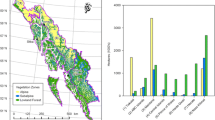Abstract
A space of “not-implausible” scenarios for Egypt's future under climate change is defined along two dimensions. One depicts representative climate change and climate variability scenarios that span the realm of possibility. Some would not be very threatening. Others portend dramatic reductions in average flows into Lake Nassar and associated increases in the likelihood of year to year shortfalls below critical coping thresholds; these would be extremely troublesome, especially if they were cast in the context of increased political instability across the entire Nile Basin. Still others depict futures along which relatively routine and relatively inexpensive adaptation might be anticipated. The ability to adapt to change and to cope with more severe extremes would, however, be linked inexorably to the second set of social–political–economic scenarios. The second dimension, defined as “anthropogenic” social/economic/political scenarios describe the holistic environment within which the determinants of adaptive capacity for water management, agriculture, and coastal zone management must be assessed.
Similar content being viewed by others
References
D. Conway and M. Hulme, Recent fluctuations in precipitation and runoff fover the Nile sub-basins and their impact on Nile discharge, Climatic Change 25 (1993) 127–151.
J.C.I. Dooge, Hydrologic models and climate change, J. Geophysical Res. 97(D3) (1992) 2677–2686.
T.E. Downing, L. Ringius, M. Hulme and D. Waughray, Adapting to climate change in Africa, Mitigation and Adaptation Strategies for Global Change 2 (1997) 19–44.
H. Eakin, Smallholder maize production and climate risk: A case study from Mexico, Climatic Change 45 (2000) 19–36.
P. Gleick, The vulnerability of runoff in the Nile Basin to climate changes, The Environmental Professional 13 (1991) 66–73.
M. Hulme, Global climate change and the Nile Basin, in: The Nile: Resource Evaluation, Resource Management, Hydropolitics and Legal Issues, eds. P.P. Howell and J. A. Allen (For a Royal Geographical Society Conference, London, 1990).
Z. Kaczmarek, On the sensitivity of runoff to climate change, WP-90-58, IIASA, Laxenburg, Austria (1990).
S. Kane and G. Yohe, Societal adaption to climate variability and change: An introduction, Climatic Change 45 (2000) 1.4.
G. Kite, Recent changes in the level of Lake Victoria, J. Hydrologic Sciences 26(23) (1981).
K.A. Miller, S. L. Rhodes and L. J. MacDonnell, Water allocation in a changing climate: Institutions and adaptation, Climatic Change 35 (1997) 157–177.
W.D. Nordhaus, Roll the Dice Again (MIT Press, Cambridge, MA, 2000).
R. Said, The River Nile: Geology, Hydrology and Utilization (Pergamon Press, Oxford, England, 1993).
D. Schimmelpfennig and G. Yohe, Vulnerability of agricultural crops to climate change: A practical method of indexing, in: Global Environmental Change and Agriculture (Edward Elgar Publishing, New York, 1998).
M. Schlesinger and L. Williams, COSMIC – COuntry Specific Model for Intertemporal Climate, Computer Software, Electric Power Research Institute, Palo Alto, CA, USA, 1998.
G. Sestini, Implications of climatic change for the Nile delta, in: Climatic Change in the Mediterranean, ed. G. Sestini (E. Arnold Publisher, London, 1993) pp. 535–601.
B. Smit, I. Burton, R. Klein and R. Street, The science of adaptation: A framework for assessment, Mitigation and Adaptation Strategies for Global Change 4 (1999) 119–213.
J. Smith, http://www-personal.umich.edu/~wddrake/julies3.jpg (2000).
K. Strzepek, D. Yates and D. El Quosy, Vulnerability assessment of water resources in Egypt to climatic change in the Nile Basin, Climate Res. 6(2) (1986).
J. Sutcliffe, A hydrological study of the Sudd Region of the upper Nile, Hydrological Sciences XIX (1974) 26.
J. Sutcliffe and V. Parks, Hydrologic modeling of the Sudd and Jongeli canal, J. Hydrologic Science 32(2) (1987).
C. Thornthwaite and B. Holzman, The determination of evaporation from land and water surfaces, Mon. Weather Review 67(1) (1939) 4–11.
R.S.J. Tol and A. Langen, A concise history of Dutch River floods, Climatic Change 46 (2000) 357–369.
D. Yates, WatBal: An integrated tool for climate change assessment on river basins, Water Resource Development 12(2) (1996) 121–139.
D. Yates, Climate change impacts on south American water resource, Climate Res. 9(2) (1997) 147–155.
D. Yates and K. Strzepek, Modeling the Nile Basin under climatic change, ASCE J. Hydrologic Engineering 3(2) (1998) 98–108.
G. Yohe and M. Schlesinger, Sea-level change: The expected cost of protection or abandonment in the United States, Climatic Change 38 (1998) 447–472.
G. Yohe, M. Jacobsen and T. Gapotchenko, Spanning 'not-implausible' futures to assess relative vulnerability to climate change and climate variability, Global Environmental Change 9 (1999) 233–249.
G. Yohe and R. Moss, Economic sustainability, indicators, and climate change, in: Climate Change and Its Linkages with Development, Equity and Sustainability, Proceedings of the IPCC Expert Meeting in Colombo, Sri Lanka (27–29 April, 1999), eds. M. Munasinghe and R. Swart (IPCC and World Meteorological Organization, Geneva, 2000).
Author information
Authors and Affiliations
Rights and permissions
About this article
Cite this article
Strzepek, K., Yates, D., Yohe, G. et al. Constructing “not Implausible” Climate and Economic Scenarios for Egypt. Integrated Assessment 2, 139–157 (2001). https://doi.org/10.1023/A:1013387619362
Issue Date:
DOI: https://doi.org/10.1023/A:1013387619362




